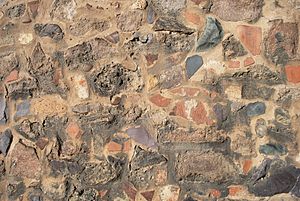Rubble facts for kids
Rubble is simply broken pieces of stone. These pieces are usually not shaped and come in many different sizes. When stone is taken from a quarry but isn't finished, it's called rubble. You might also find natural rubble in the soil, especially when the land is ploughed. This natural rubble is sometimes called brash.
Building with Rubble
"Rubble-work" is a way of building with stone. One method involves loosely placing stones between boards. Then, a mix called mortar is poured over them, almost like concrete. This method is known as "muraglia di getto" in Italian and "bocage" in French. In Pakistan, walls made this way with rubble and concrete are called 'situ'. This word likely comes from Sanskrit, meaning "made on the spot."
Walls built using large, unshaped stones without any neat rows are called rubble walls. These stones are placed randomly and held together with mortar. If similar stones are laid in neat rows, it's called coursed rubble.
Dry-Stone Walls
Dry-stone walling is a bit like rubble work, but it uses no mortar at all. The stones are carefully fitted together. They are also placed so that some stones go all the way through the wall's thickness. This makes the wall strong and stable. A rubble wall built with mortar will be even stronger if it uses this fitting method. However, building Building foundations with rubble often lets water leak in, making them damp.
Smart Rubble Walls in Malta

Rubble walls (Maltese: ħitan tas-sejjieħ) are common all over the island of Malta. You can also find similar walls in Sicily and many Arab countries. The stones used in these walls look like they were simply picked up from the ground nearby. It's thought that the idea for these walls came from the Arabs. They ruled Malta and Sicily around the same time.
Maltese farmers found these walls very useful, especially when building materials were hard to find. Rubble walls act as borders between different farms. A big benefit of these walls is how they handle heavy rain. Their structure lets extra water pass through, so it doesn't harm the crops. They also help prevent soil erosion. The walls let water through but trap the soil, stopping it from being washed away. You can see many rubble walls on hillsides and in valleys. This is where the land slopes, and soil is more likely to be carried away.


